Stuttgarter Beiträge zur Naturkunde - Staatliche Museen für ...
Stuttgarter Beiträge zur Naturkunde - Staatliche Museen für ...
Stuttgarter Beiträge zur Naturkunde - Staatliche Museen für ...
You also want an ePaper? Increase the reach of your titles
YUMPU automatically turns print PDFs into web optimized ePapers that Google loves.
schmalfuss et al., bibliography of terrestrial isopods 47<br />
– (1956): Fauna van Nederland. Aflevering 16. Isopoda en Tanaidacea, 280 pp.; Leyden.<br />
HOPKIN, S. (1986): Ecophysiological strategies of terrestrial arthropods for surviving heavy<br />
metal pollution. – Proceedings of the 3 rd European Congress of Entomology, pp.<br />
263–266; Amsterdam.<br />
– (1990 a): Critical concentrations, pathways of detoxification and cellular ecotoxicology<br />
of metals in terrestrial arthropods. – Funct. Ecol. 4: 321–327; Oxford.<br />
– (1990 b): Species-specific differences in the net assimilation of zinc, cadmium, lead, copper<br />
an iron by the terrestrial isopods Oniscus asellus and Porcellio scaber. – J. appl Ecol.<br />
27: 460–474; Oxford.<br />
HOPKIN, S. & HAMES, C. (1994): Zinc, among the „cocktail“ of metal pollutants, is responsible<br />
for the absence of the terrestrial isopod Porcellio scaber from the vicinity of a primary<br />
smelting works. – Ecotoxicol. 2: 68–78; London.<br />
HOPKIN, S., HAMES, C. & BRAGG, S. (1989): Terrestrial isopods as biological indicators of zinc<br />
pollution in the Reading area, south east England. – Monitore zool. ital. (N.S.), Monogr.<br />
4: 477–488; Florence.<br />
HOPKIN, S., HAMES, C. & DRAY, A. (1989): X-ray microanalytical mapping of the intracellular<br />
distribution of pollutant metals. – Microsc. Anal. 14: 23–27; Bookham.<br />
HOPKIN, S., HARDISTY, G. & MARTIN, M. (1986): The woodlouse Porcellio scaber as a „biological<br />
indicator“ of zinc, cadmium, lead and copper pollution. – Environm. Pollut. 11 B:<br />
271–290; Dordrecht.<br />
HOPKIN, S., JONES, D. & DIETRICH, D. (1993): The isopod Porcellio scaber as a monitor of the<br />
bio-availability of metals in terrestrial ecosystems: towards a global „woodlouse<br />
watch“ scheme. – In: The Science of the total Environment, Suppl., pp. 357–365; Amsterdam.<br />
HOPKIN, S. & MARTIN, M. (1982 a): The distribution of zinc, cadmium, lead and copper within<br />
the woodlouse Oniscus asellus. – Oecologia 54: 227–232; Berlin.<br />
– & – (1982 b): The distribution of zinc, cadmium, lead and copper within the hepatopancreas<br />
of a woodlouse. – Tissue Cell 14: 703–715; Edinburgh.<br />
– & – (1984): Heavy metals in woodlice. – Symp. zool. Soc. Lond. 53: 143–166; London.<br />
– & – (1985): Assimilation of zinc, cadmium, lead, copper, and iron by the spider Dysdera<br />
crocata, a predator of woodlice. – Bull. environm. Contam. Toxicol. 34: 183–187; New<br />
York.<br />
HOPKIN, S., MARTIN, M. & MOSS, S. (1985): Heavy metals in isopods from the supra-littoral<br />
zone on the southern shore of the Severn Estuary, UK. – Environm. Pollut. 9 B:<br />
239–254; Dordrecht.<br />
HORNUNG, E. (1981 a): Data on the oxygen consumption of Isopoda and Diplopoda species.<br />
– Acta biol. Szeged 27: 209–213; Szeged.<br />
– (1981 b): Investigations on the productivity of the macrodecomposer isopod, Trachelipus<br />
nodulosus. – Acta biol. Szeged. 27: 203–208; Szeged.<br />
– (1984): Characteristics of the population of an Isopoda species (Trachelipus nodulosus)<br />
at sandy soil grassland. – Acta biol. Szeged 30: 153–158; Szeged.<br />
– (1989): Population dynamics and spatial distribution of Trachelipus nodulosus in a sandy<br />
grassland. – Monitore zool. ital. (N.S.), Monogr. 4: 399–409; Florence.<br />
– (1991): Isopod distribution in a heterogeneous grassland habitat. – In: JUCHAULT, P. &<br />
MOCQUARD, J. (eds.): The Biology of Terrestrial Isopods III. Proceedings of the Third<br />
International Symposium on the Biology of Terrestrial Isopods, pp. 73–79; Poitiers.<br />
– (1996): Reproductive strategies and spatio-temporal patterns of terrestrial isopod populations.<br />
– Acta biol. Szeged 41: 119–122; Szeged.<br />
HORNUNG, E., FISCHER, E. & FARKAS, S. (1998): Isopod reproduction as a tool for sublethaltoxicity<br />
tests. – Israel J. Zool. 44: 445–450; Jerusalem.<br />
HORNUNG, E. & WARBURG, M. (1993): Breeding patterns in the oniscid isopod, Porcellio ficulneus,<br />
at high temperature and under different photophases. – Invert. Reprod. Developm.<br />
23: 151–158; Philadelphia.<br />
– & – (1994): Oosorption and oocyte loss in a terrestrial isopod under stressful conditions.<br />
– Tissue Cell 26: 277–284; Edinburgh.<br />
– & – (1995 a): Seasonal changes in the distribution and abundance of isopod species in different<br />
habitats within the Mediterranean region of northern Israel. – Acta oecol. 16:<br />
431–445; Paris.



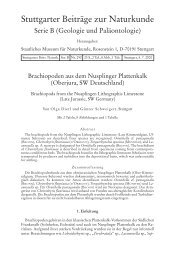

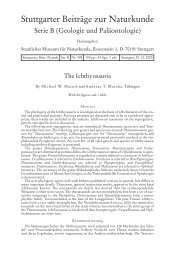


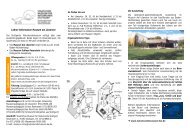


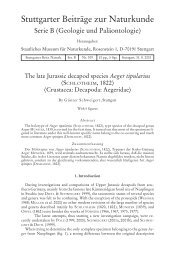
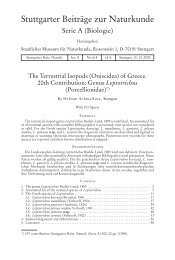
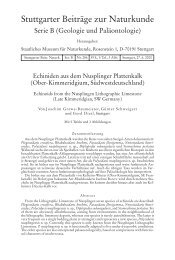
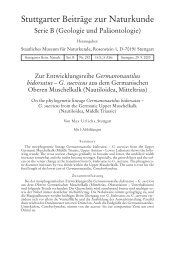
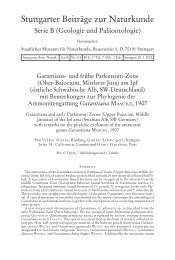
![[PDF] Stuttgarter Beiträge zur Naturkunde](https://img.yumpu.com/5473603/1/175x260/pdf-stuttgarter-beitrage-zur-naturkunde.jpg?quality=85)